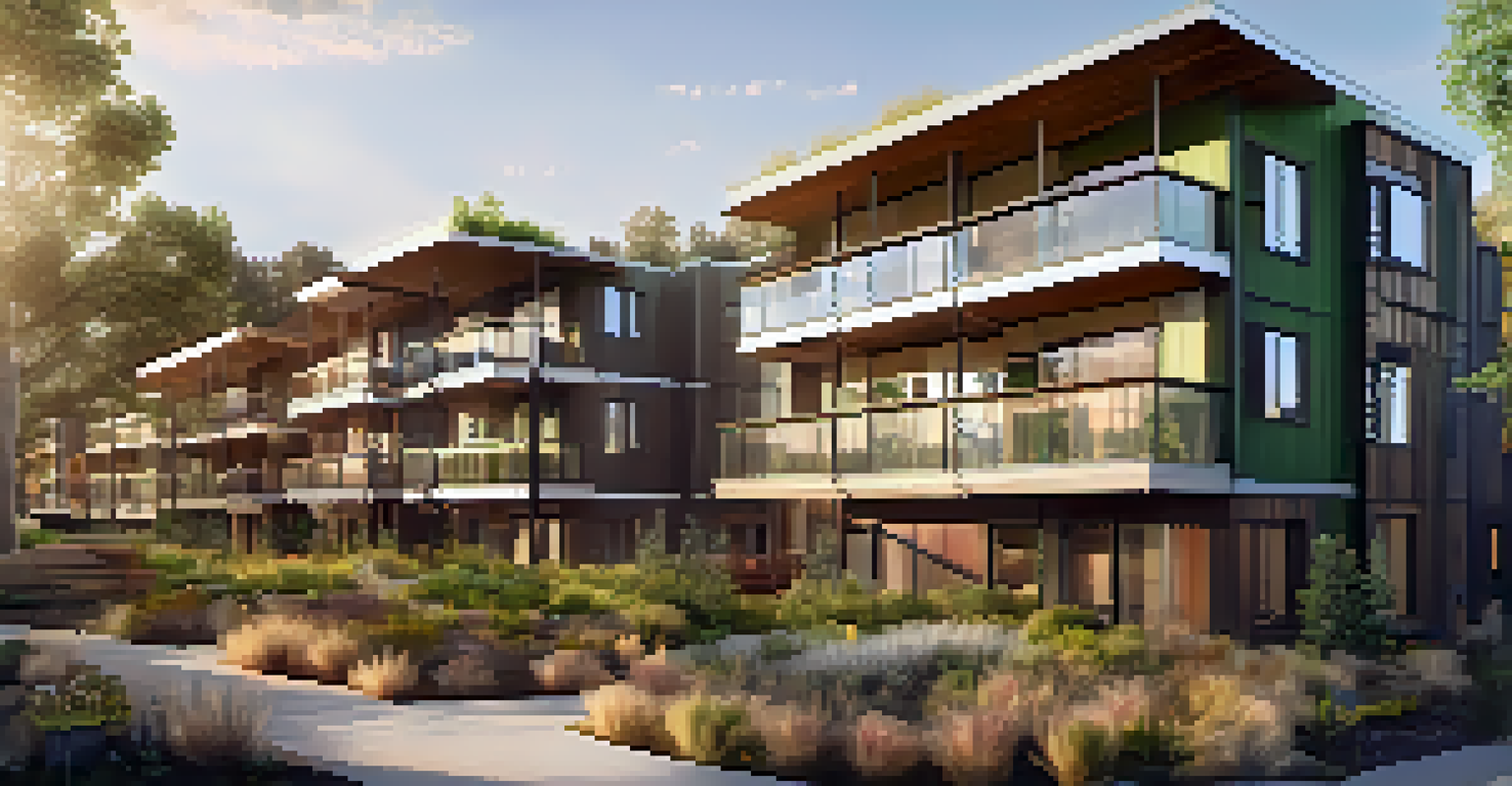Examining the Rental Market and Affordability in Colorado

Overview of Colorado's Rental Market Trends
The rental market in Colorado has seen significant shifts in recent years, largely driven by population growth and economic development. As more people move to the state for its stunning landscapes and job opportunities, demand for rental properties has surged. This influx has not only increased competition among renters but also pushed rental prices to new heights.
Housing is absolutely essential to human flourishing. Without stable housing, you can’t have stable families or stable communities.
In cities like Denver and Boulder, the average rent has risen dramatically, making it increasingly challenging for residents to find affordable housing. A two-bedroom apartment in the Denver area can easily exceed $2,500, which is a steep price for many families and individuals. The dynamics of this market reflect broader national trends, but Colorado's unique allure exacerbates the issue.
As we dive deeper, it's essential to consider how these trends impact various demographics, from students and young professionals to families and retirees. Each group faces different challenges in navigating the rental landscape, highlighting the need for targeted solutions to improve affordability.
Factors Influencing Rent Prices in Colorado
Several key factors contribute to the rising rent prices in Colorado, including job growth, limited housing supply, and zoning regulations. The state's booming tech and energy sectors have created a wealth of job opportunities, attracting new residents who are eager to settle down in vibrant communities. However, the supply of rental units hasn’t kept pace with this influx, leading to higher competition for available housing.

Additionally, restrictive zoning laws and the slow pace of new construction projects have further tightened the market. Many areas struggle with the balance between preserving community character and accommodating growth, making it difficult for developers to build new units. This combination of high demand and constrained supply inevitably drives prices up.
High Demand Driving Rent Prices Up
Colorado's rental market is experiencing soaring prices due to an influx of new residents and limited housing supply.
Lastly, it’s crucial to acknowledge the impact of interest rates and the overall economy on the rental market. As mortgage rates fluctuate, more individuals may opt to rent rather than buy, adding additional pressure to the already competitive rental landscape.
Demographics of Renters in Colorado
The demographics of renters in Colorado are diverse, reflecting a mix of young professionals, families, and retirees. In urban areas, millennials and Gen Z are particularly prominent, often seeking flexibility and proximity to work and entertainment. Meanwhile, families with children may be drawn to suburban areas, looking for good schools and safer neighborhoods.
The greatest challenge in the housing market is not just building houses but building communities that can support diverse populations.
Retirees are also becoming a significant part of the rental market, especially in scenic regions like the Rockies. Many older adults prefer renting to owning, as it allows them to downsize and enjoy a more manageable lifestyle. This shift in demographics is reshaping the types of rental properties in demand across the state.
Understanding these demographic trends can help property owners and developers better cater to the needs of their tenants. By providing suitable housing options, they can foster a more inclusive rental market that addresses the diverse needs of Colorado's residents.
Challenges of Affordability for Colorado Renters
Affordability remains a pressing issue for many renters in Colorado, particularly in high-demand areas. With rental prices skyrocketing, a significant portion of residents find themselves spending more than 30% of their income on housing—a benchmark that often signals financial strain. This can lead to tough choices, such as sacrificing necessities or facing the risk of eviction.
Moreover, the rising cost of living in conjunction with stagnant wages exacerbates the affordability crisis. Many renters are caught in a cycle where their salaries do not keep pace with increasing rents, making it increasingly difficult to secure stable housing. This issue is particularly acute for low-income families and individuals who may have fewer options available.
Diverse Renters Face Affordability Issues
Various demographics, from young professionals to retirees, are struggling with rising rental costs that often exceed 30% of their income.
While some local governments have introduced measures to address affordability, including rent control and housing assistance programs, the effectiveness of these initiatives varies. Continuous advocacy and innovative policy solutions are essential to help alleviate the burden on renters and ensure that everyone can find a place to call home.
The Role of Government Policies in Rental Affordability
Government policies play a vital role in shaping the rental market and addressing affordability challenges in Colorado. From zoning laws to affordable housing initiatives, the decisions made at the local, state, and federal levels can significantly impact the availability and cost of rental properties. For instance, policies that encourage new construction can help alleviate supply constraints and stabilize prices.
Moreover, programs aimed at providing financial assistance to low-income renters can make a meaningful difference in individuals' lives. These initiatives can help families secure stable housing while also stimulating the local economy by keeping residents in their communities. However, the effectiveness of these policies often depends on adequate funding and public support.
It's essential for lawmakers to engage with community members to understand their needs and challenges. By fostering open dialogue and collaboration, they can develop policies that not only promote growth but also prioritize affordability and accessibility for all residents.
Future Prospects for Colorado's Rental Market
Looking ahead, the future of Colorado's rental market will be shaped by various factors, including economic conditions, demographic shifts, and ongoing policy changes. As the state continues to attract new residents, the demand for rental properties is likely to persist, necessitating a robust response from developers and policymakers alike. This could mean more innovative housing solutions, such as co-housing or mixed-use developments.
Additionally, the growing emphasis on sustainability and environmentally friendly practices may influence the types of rental properties that are built. Eco-friendly designs and energy-efficient features are becoming increasingly appealing to renters, particularly younger generations who prioritize sustainability. This trend could lead to a shift in how properties are marketed and developed.
Government Policies Impact Affordability
Local and state policies play a crucial role in addressing the rental affordability crisis through initiatives aimed at increasing supply and providing financial assistance.
Ultimately, the path forward must prioritize both growth and affordability. By striking this balance, Colorado can continue to thrive as a desirable place to live while ensuring that all residents have access to safe and affordable housing options.
Conclusion: Navigating the Rental Landscape in Colorado
Navigating the rental landscape in Colorado can be a challenging endeavor, but understanding the key dynamics at play can empower renters to make informed decisions. From recognizing the factors that influence rent prices to appreciating the diversity of the rental market, knowledge is a powerful tool for individuals seeking housing. It’s essential for renters to explore various options and stay informed about their rights and resources.
As Colorado's rental market continues to evolve, it will be crucial for all stakeholders—renters, landlords, and policymakers—to work together to foster a fair and sustainable environment. By addressing affordability challenges and advocating for effective solutions, the state can ensure that it remains an attractive place for all its residents.

In summary, while the rental market in Colorado presents its challenges, it also offers opportunities for growth and collaboration. By staying engaged and informed, renters can better navigate this complex landscape and ultimately find a place they can call home.